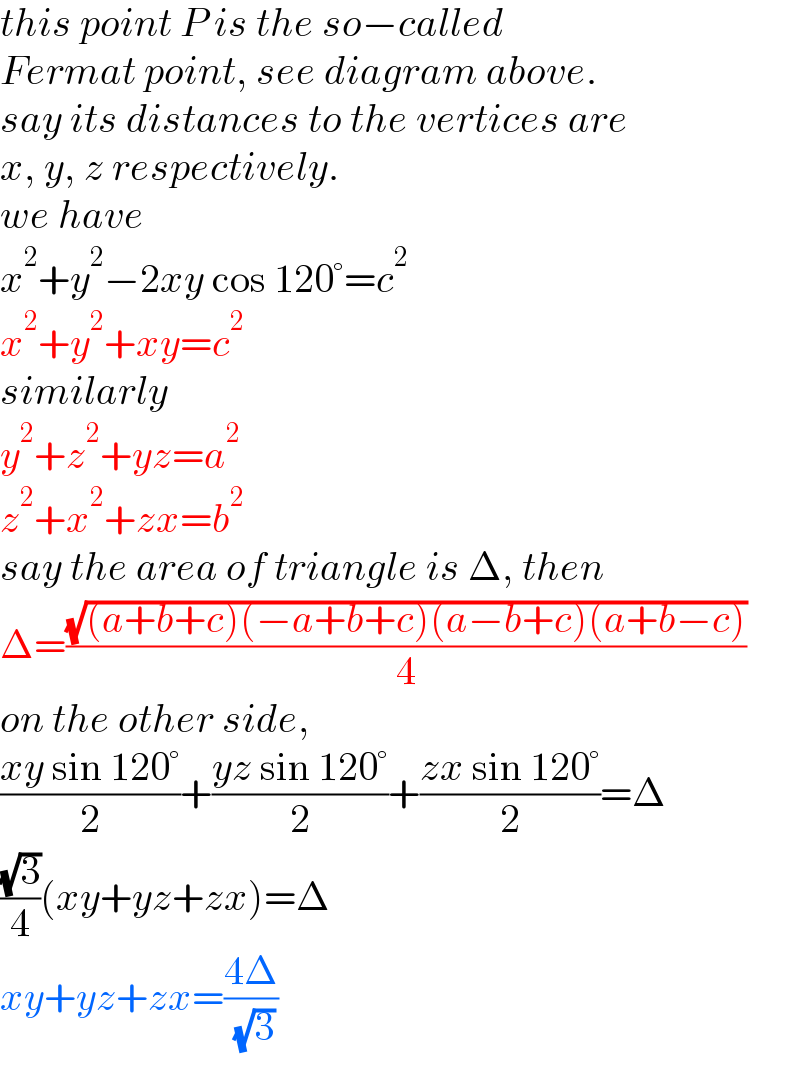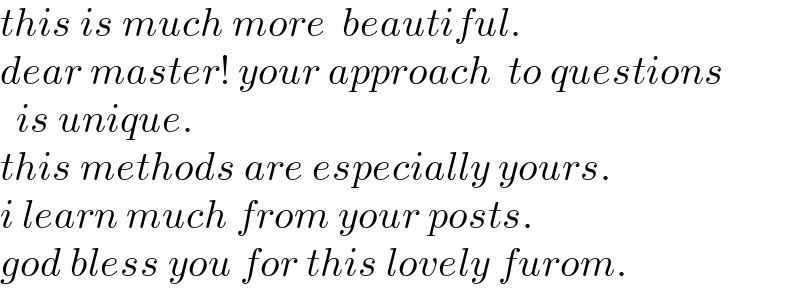
Question and Answers Forum
Question Number 164174 by mr W last updated on 15/Jan/22

Commented by mr W last updated on 15/Jan/22

Answered by mr W last updated on 15/Jan/22

Commented by mr W last updated on 15/Jan/22

Commented by mr W last updated on 15/Jan/22

Commented by mr W last updated on 16/Jan/22
![BA′=(2/3)×(((√3)a)/2)=(((√3)a)/3) BC′=(((√3)c)/3) ∠A′BC′=∠B+60° C′A′^2 =((((√3)a)/3))^2 +((((√3)c)/3))^2 −2×(((√3)a)/3)×(((√3)c)/3) cos (∠B+60°) C′A′^2 =((a^2 +c^2 −ac(cos ∠B−(√3) sin ∠B) )/3) C′A′^2 =(1/3)[a^2 +c^2 −ac(((a^2 +c^2 −b^2 )/(2ac))−((2(√3)Δ)/(ac)))] C′A′^2 =((a^2 +b^2 +c^2 +4(√3)Δ)/6) C′A′=A′B′=B′C′=(√((a^2 +b^2 +c^2 +4(√3)Δ)/6))=d, say (this is the side length of Napoleon triangle A′B′C′) ((yd)/2)=(((√3)a)/3)×(((√3)c)/3)×sin (∠B+60°)=area [PA′BC′] y=((ac)/(3d))×(sin ∠B+(√3) cos ∠B) y=((ac)/(3d))×(((2Δ)/(ac))+(√3) ×((a^2 +c^2 −b^2 )/(2ac))) y=((4Δ+(√3)(a^2 −b^2 +c^2 ))/(6d)) y=((4(√6)Δ+3(√2)(a^2 −b^2 +c^2 ))/( 6(√(a^2 +b^2 +c^2 +4(√3)Δ)))) similarly x=((4(√6)Δ+3(√2)(−a^2 +b^2 +c^2 ))/( 6(√(a^2 +b^2 +c^2 +4(√3)Δ)))) z=((4(√6)Δ+3(√2)(a^2 +b^2 −c^2 ))/(6(√(a^2 +b^2 +c^2 +4(√3)Δ)))) x+y+z=(√((a^2 +b^2 +c^2 +4(√3)Δ)/2)) ■](Q164223.png)
Commented by behi834171 last updated on 15/Jan/22
![very nice solution,dear master.thanks a lot. a=b=c⇒Δ=a^2 .((√3)/4) 4(√3)Δ+b^2 +3c^2 −a^2 =4(√3)×a^2 .((√3)/4)+3a^2 =6a^2 4(√3)Δ+a^2 +b^2 +c^2 =4(√3)×a^2 .((√3)/4)+3a^2 =6a^2 ⇒y=x=z=(√(((4a^2 )/3)−a^2 ))=a.((√3)/3) .■ [also see q≠14157]](Q164232.png)
Commented by mr W last updated on 15/Jan/22

Commented by Tawa11 last updated on 15/Jan/22

Commented by Tawa11 last updated on 15/Jan/22

Commented by behi834171 last updated on 15/Jan/22

Commented by mr W last updated on 15/Jan/22

